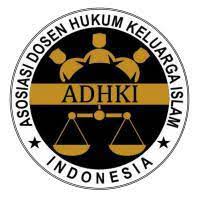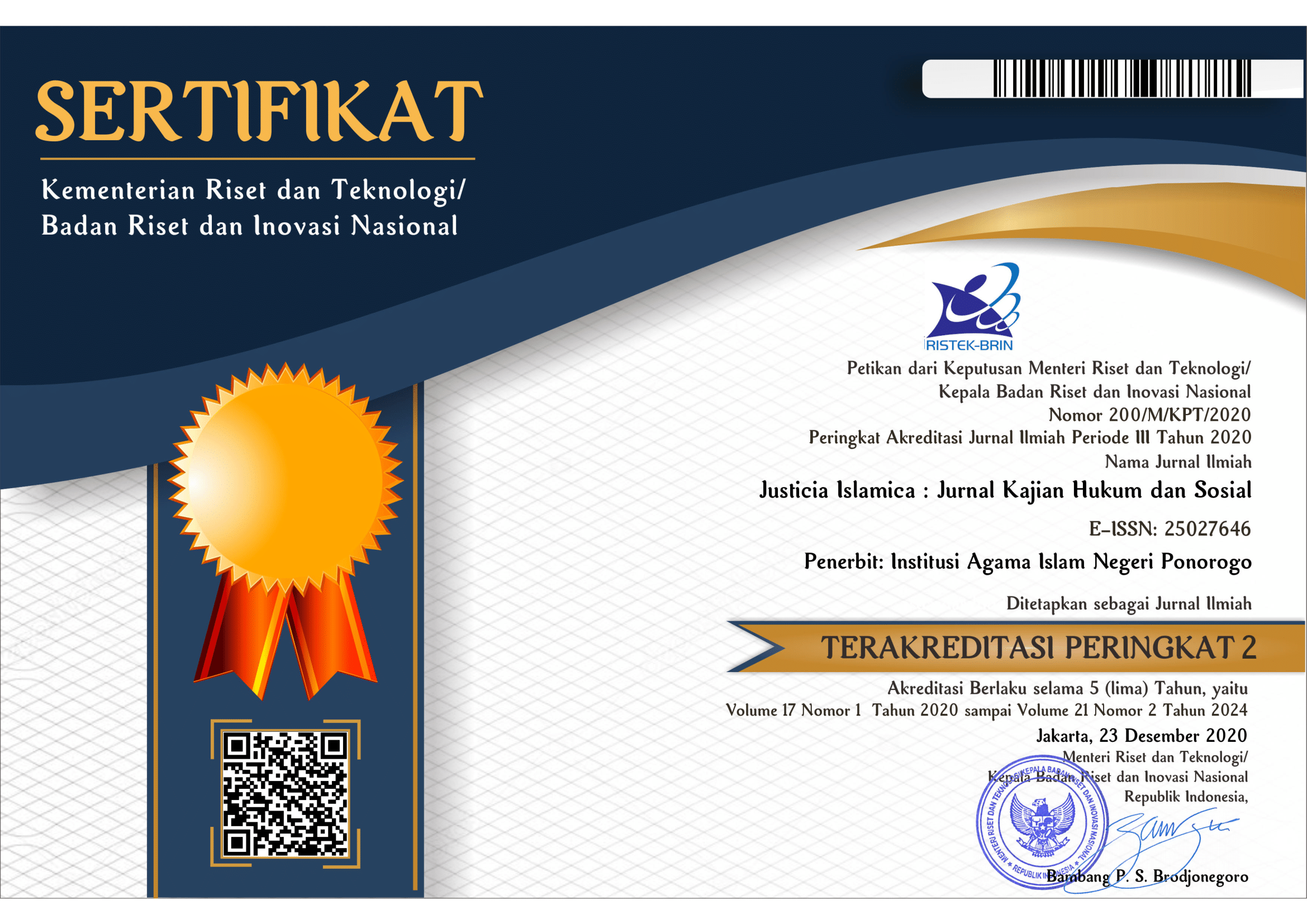Optimizing the Wukuf-”˜Arafah Time Determination Model According to the Governments of Saudi Arabia and Indonesia
DOI:
https://doi.org/10.21154/justicia.v19i2.4839Keywords:
eid al-Adha, Ummul Qura calendar, new criteria for MABIMSAbstract
Eid al-Adha is a historic moment for Muslims not only in Indonesia but also for Muslims around the world. Based on astronomical reckoning data, it is known that determining the beginning of the month of Dzulhijja 1443 H is essential to have a difference. This is interesting to study because it has an impact on Muslims. For the government of Saudi Arabia, the Ummul Qura calendar is a civil calendar used for administrative purposes. Meanwhile, for the sake of worship, determining religious days in one of them determines that Ramadan, Shawwal, and Dzulhijja become the authority of the al-Qodi al-a'la assembly. The Government of Indonesia, through the Ministry of Religion as of Ramadan 1443 H, has used the MABIMS New Criteria in determining the beginning of the Hijriya month so that with the enactment of this new criterion, there is a difference in determining the time of Wukuf-Arafah between the Saudi and Indonesian Governments. Based on these differences in determination, two problem formulations want to be studied further. First, how do the Saudi and Indonesian Governments use the model/method in determining the time of wukuf-arafah, and secondly, for Muslims with differences in determining the time of wukuf-arafah? To answer the formulation of the problems, this study analyzes it based on the Ummul Qura Calendar system used by the Saudi Government and Imkanur rukyat with the new MABIMS criteria used by the Indonesian Government. One application of the new MABIMS criteria in Indonesia is the difference in Eid al-Adha between the Government of Indonesia and one of the religious mass organizations, Muhammadiyah. Another implication is that various polemics are developing in the community regarding whether or not fasting the Sunnah of Arafah is different from the determination of the day of Wukuf.
References
Aini, Shofwatul. “A Discourse of MABIMS New Criteria (Reading Difference Frequency Between Wujud al-Hilal and Imkan Ar-Rukyat).” Justicia Islamica: Jurnal Kajian Hukum Dan Sosial 19, no. 1 (June 28, 2022): 113”“31. https://doi.org/10.21154/justicia.v19i1.3394.
’Alwani, Taha J. al. “The Islamic Lunar Calendar as a Civilizational Imperative: 29 Rabi’ al Awai - 1 Rabi’ al Akhir/8-10 October 1991 Penang, Malaysia.” American Journal of Islam and Society 9, no. 4 (January 1, 1992): 577”“83. https://doi.org/10.35632/ajis.v9i4.2546.
Angkat, Arbisora. “Kalender Hijriah Global Dalam Perspektif Fikih.” Al-Marshad: Jurnal Astronomi Islam Dan Ilmu-Ilmu Berkaitan 3, no. 2 (December 30, 2017). https://doi.org/10.30596/jam.v3i2.1524.
Anwar, Syamsul. “Unifikasi Kalender Hijriah Global Problem Dan Tantangan.” Al-Marshad: Jurnal Astronomi Islam Dan Ilmu-Ilmu Berkaitan 2, no. 2 (2016). https://doi.org/10.30596/jam.v2i2.2548.
Aris, Nur. “Dinamika Kriteria Penentuan Awal Bulan Kamariah Dalam Penanggalan Umm Al-Qura Sejak 1346 H/1927 M ”“ 1436 H/2015 M.” Disertassion, UIN Walisongo, 2006. http://eprints.walisongo.ac.id/id/eprint/11904/.
””””””. “Dinamika Kriteria Penentuan Awal Bulan Qamariah Dalam Penanggalan Umm Al-Qura’ Saudi Arabia.” Al-Ahkam Jurnal Ilmu Syari’ah Dan Hukum 1, no. 1 (June 30, 2016). https://doi.org/10.22515/alahkam.v1i1.97.
Azhari, Susiknan. “Penyatuan Kalender Islam: Mendialogkan Wujûd al-Hilâl Dan Visibilitas Hilal.” AHKAM : Jurnal Ilmu Syariah 13, no. 2 (August 7, 2013). https://journal.uinjkt.ac.id/index.php/ahkam/article/view/931.
Budiwati, Anisah. “Telaah Awal Kalender Hijriah Global Tunggal Jamaluddin Abd Al-Razik: Sebuah Upaya Menuju Unifikasi Kalender.” Jurnal Bimas Islam 10, no. 3 (September 30, 2017): 407”“30. https://doi.org/10.37302/jbi.v10i3.29.
Fuscha, Fika Afhamul. “Verification of The Hisab Ephemeris System Against The Hijri Calendar Leap Year Pattern With Criteria Imkan Al-Rukyah Mabims (Case Study in Kudus District).” Al-Hilal: Journal of Islamic Astronomy 3, no. 1 (May 19, 2021): 107”“28.
Hamdani, Aris Tiono. “Analisis Perspektif Empat Madzhab Terhadap Matla’ Dalam Penentuan Awal Bulan Hijriah.” AL - AFAQ : Jurnal Ilmu Falak Dan Astronomi 4, no. 1 (June 30, 2022): 32”“39. https://doi.org/10.20414/afaq.v4i1.4187.
Hosen, Hosen. “Kilas Balik Kalender Hijriyah Indonesia Perjalanan Menuju Penyatuan Kalender Nasional.” Islamuna: Jurnal Studi Islam 4, no. 1 (July 1, 2017): 81”“111. https://doi.org/10.19105/islamuna.v4i1.1352.
Kusdiyana, Kusdiyana. “Penentuan Awal Bulan Hijriah Menurut Mazhab Syafii.” Mahkamah : Jurnal Kajian Hukum Islam 5, no. 2 (October 20, 2020): 231”“47. https://doi.org/10.24235/mahkamah.v5i2.7137.
Maskufa. “Global Hijriyah Calendar As Challenges Fikih Astronomy,” 188”“92. Atlantis Press, 2017. https://doi.org/10.2991/iclj-17.2018.39.
Maskufa, Maskufa, Sopa Sopa, Sri Hidayati, and Adi Damanhuri. “Implementation of the New MABIMS Crescent Visibility Criteria: Efforts to Unite the Hijriyah Calendar in the Southeast Asian Region.” AHKAM : Jurnal Ilmu Syariah 22, no. 1 (June 30, 2022). https://journal.uinjkt.ac.id/index.php/ahkam/article/view/22275.
Miles, Matthew B., A. Michael Huberman, and Johnny Saldana. Qualitative Data Analysis: A Methods Sourcebook. SAGE Publications, 2013.
Musonnif, Ahmad. “Kalender Umm Al-Qura (Studi Pergeseran Paradigma Sistem Kalender Di Kerajaan Arab Saudi) | Ahkam: Jurnal Hukum Islam.” Ahkam 3, no. 2 (2015): 165”“85. https://doi.org/10.21274/ahkam.2015.3.2.165-186.
Rohmah, Nihayatur. “Merekonstruksi Peradaban Islam Di Indonesia Dengan Mewujudkan Kalender Hijriyah.” Al-Mabsut : Jurnal Studi Islam Dan Sosial 10, no. 1 (2016). https://doi.org/10.56997/almabsut.v10i1.107.
Saksono, Tono. “Kalender Islam Global: Perspektif Syariah, Ekonomi, dan Politik.” JURIS (Jurnal Ilmiah Syariah) 15, no. 2 (March 18, 2017): 143”“52. https://doi.org/10.31958/juris.v15i2.495.
Syarif, Muh Rasywan. Perkembangan Perumusan Kalender Islam Internasional Studi Atas Pemikiran Mohammad Ilyas. Jakarta: Gaung Persada Press, 2019.
Wildan, David, and Ahmad Adib Rafiuddin. “Penentuan Awal Bulan Hijriah Perspektif Mazhab Maliki.” Tafáqquh: Jurnal Penelitian Dan Kajian Keislaman 9, no. 2 (December 1, 2021): 275”“94. https://doi.org/10.52431/tafaqquh.v9i2.597.
Yaqin, Ahmad Ainul. “Peluang Dan Tantangan Kalender Islam Internasional Mohammad Ilyas.” Azimuth: Journal of Islamic Astronomy 1, no. 1 (January 30, 2020): 32”“51.
Downloads
Published
Issue
Section
License
Requirements to be met by the author as follows:
- Author storing copyright and grant the journal right of first publication manuscripts simultaneously with licensed under the CC BY-SA allows others to share the work with a statement of the work's authorship and initial publication in this journal.
Authors can enter into the preparation of additional contractual separately for the non-exclusive distribution of a decadent version of the journal issue (e.g., post it to an institutional repository or publish it in a book), with the recognition of initial publication in this journal.
Authors are allowed and encouraged to post their work online (e.g., in institutional repositories or on their website) before and during the submission process because it can lead to productive exchanges and citations earlier and more severe than published works. (see The Effect of Open Access).
This work is licensed under CC BY-SA.


















